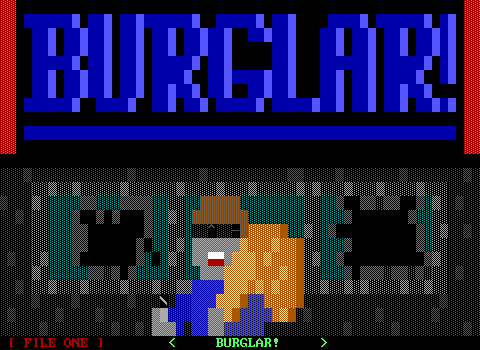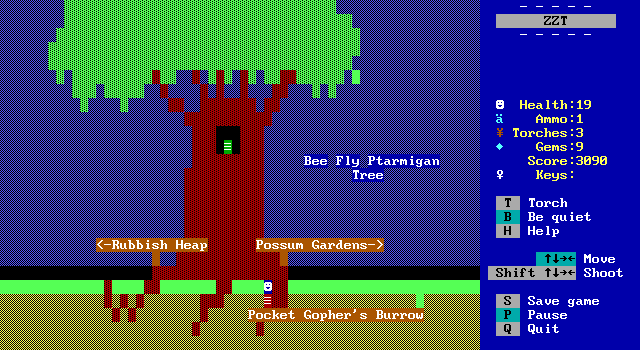
It's not readily apparent where the player needs to go at this point, but pretty straightforward to go left to right searching. Sundria also includes a text file containing a basic walkthrough for the game, so the player has no reason to get stuck for long. Here, the next place to go is a second trip to the pocket gopher's burrow.

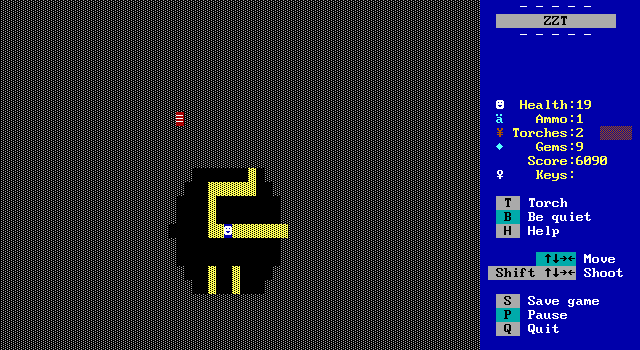
The gopher burrows a tunnel to the center of the earth, which is obviously Louis's next location.
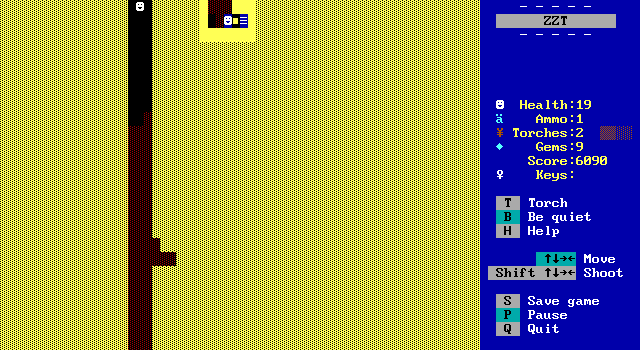
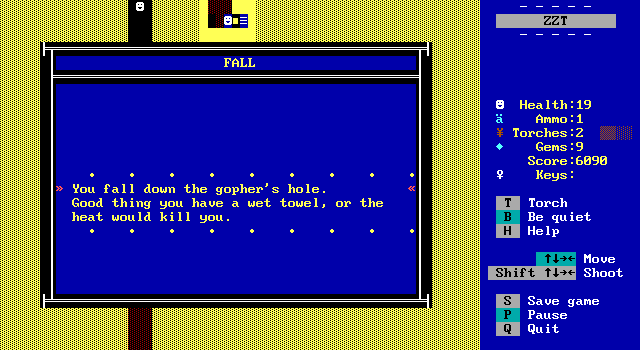
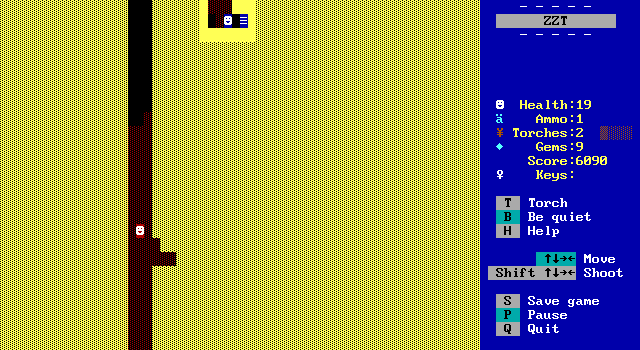
This board caught me off guard. I didn't recognize it as a cutscene, instead thinking the object was supposed to be the gofer at first. I think this is the first cutscene board I've ever seen in ZZT where the player gets to it by moving from one board to the next rather than taking a passage. Similarly, the player not being in one of the board's corners for the cutscene is also a bit unusual, though not completely unheard of. The cutscene doesn't begin until the player touch the boulder object blocking the passage, adding to the confusion.
If the player didn't pick up the wet towel in Louis's house they'll be killed here due to the heat.
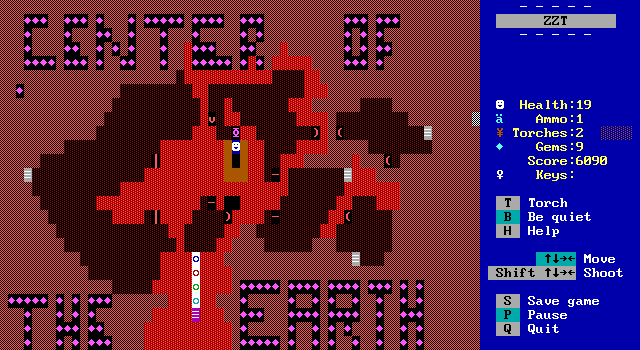
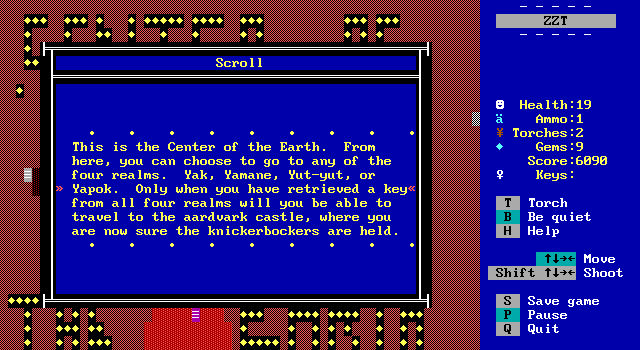
A scroll welcomes Louis to the center of the earth, the hub for the rest of the game. Here things get a bit more traditionally ZZT with a quest to travel to four areas, obtain a key, and unlock some central doors, which in this case lead to the castle of the aardvarks.
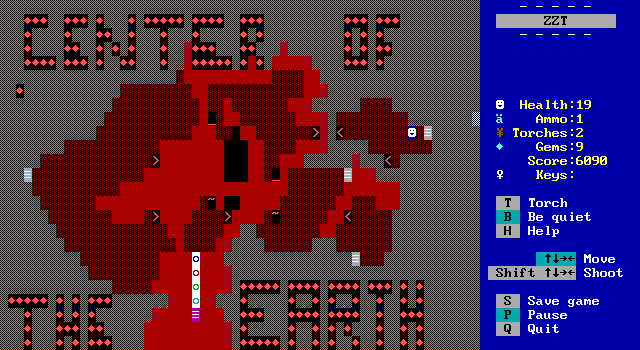
The gems that make up the text flash different colors, and the walks in the center of the board use blinking colors. The blinking walls in the rubbish heap could be explained as toxic waste, and I suppose the walls here could be claimed to be magma, but I was beginning to get pretty suspicious about these blinking walls and whether or not they were intended to be blinking.

Like Town, the player is given free reign of which path they'd like to take first. The passage I happened to reach first led to Yamane Desert. Each area has a sort of introduction board like this one, with pushers to push the player towards the next board whether they want to move on or not.
Pushers can't actually push a player off screen, so there's still some manual input required. Later ZZT games that wanted to have a sort of intermission screen without player input being needed would duplicate a passage on top of a player clone to automatically make the warp.
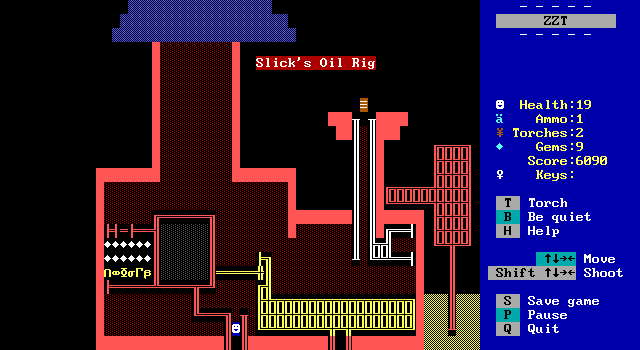
Yamane begins in an oil rig which I wouldn't have identified as such without the text label. There's a blinkwall as a simple obstacle, and a room full of gems and some strange looking objects.

Touching the break in the line wall reveals that it's a pipe leaking hot oil and that the player can't proceed. There's code to get past the pipe by plugging it up with a wad of phlegm given to the player by another character, but that requires doing these four areas in a different order than the one I chose.
The objects are all various foodstuffs which give and take health depending on Louis's tastes. From left to right there's trail mix (good), a Bunsen burner with burnt stuff stuck to it (good), a kettle of fish (good), a bowl of cold oatmeal (bad), a lutefisk sandwich (bad), and a lamburger with relish (good).

Outside the oil rig is an ad for a... pickle vat?

And a scroll with additional information on that.
Again with this board, the normal walls that make up the animal on the billboard are blinking. It very much feels like a mistake, and by now I was sure that the blinking walls were not supposed to be such. So let's get into how such a thing could happen (since it's just going to keep on happening throughout the rest of the game).
ZZT's text mode uses blinking characters rather than high intensity backgrounds (much to the dismay of everybody trying to squeeze out better graphics). That some characters are flashing on and off like this should be obvious when working on the game, but for some reason Sundria manages to not notice this. Blame Windows! If you happen to run ZZT on an older Windows machine with native MS-DOS support, it'll run in a window rather than fullscreen by default. When running in a window, the blinking is replaced with high intensity backgrounds. So what happened here is almost certainly that the game was made on a Windows machine and either Yapok was unaware about the discrepancy in graphics or intended the game to be ran in a window on Windows.
So technically the presentation of these screenshots isn't representative of how the game is meant to look. In Dosbox, the easiest way around this is with the utility BlinkX which forces high intensity backgrounds. It's not a huge deal as far as gameplay goes, but the blinking definitely makes some boards feel odd.
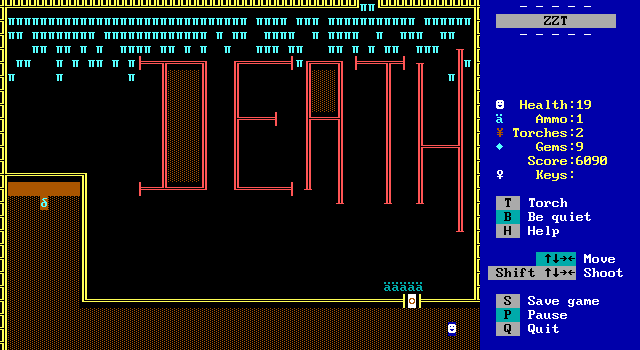
Moving along to the next screen, there's a large section of the room locked away and filled with walls that are immediately transformed into tigers. ZZT can only support so many elements with stats like these tigers on the screen at once so the rest simply become empty spaces. The stat limit being hit has a fun effect of meaning the tigers are unable to shoot since their projectiles require a stat to be available.
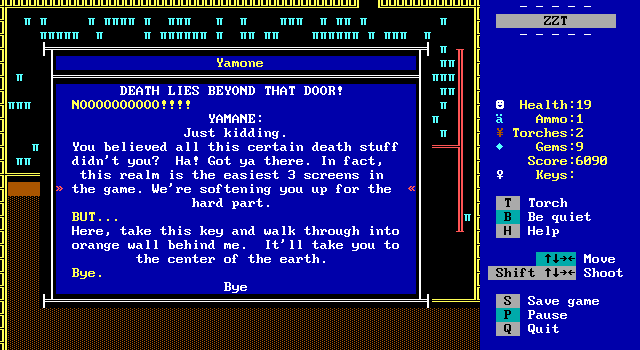
Yamane/Yamone (if you want to look at the object's name) gives Louis the first key to the castle of the aardvarks and reveals that there's no need to fight the tigers.
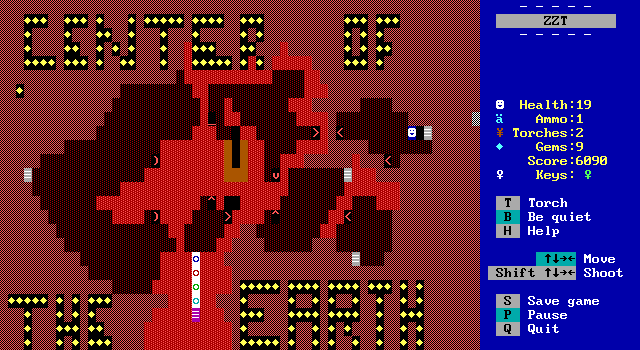
Key acquired, there are still three more passages to go through.
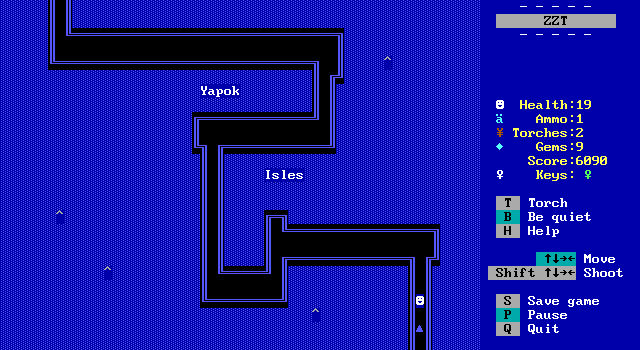
The leftmost passage leads to Yapok Isles. The player is pushed upwards, but has to walk this twisty passage on their own.
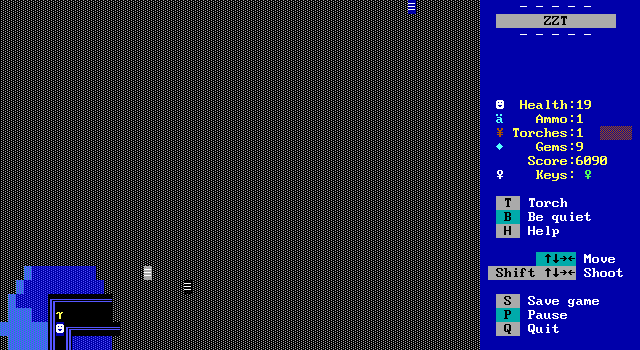
They'll arrive on a dark screen and promptly acquires a flashlight which gives 300 torches. After Aceland I'm glad to see I won't have to worry about running out of light.
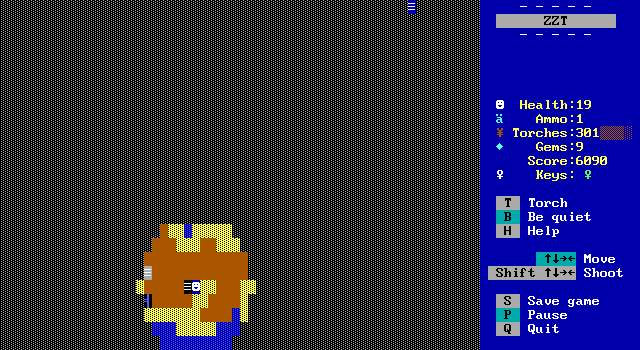

The path leads them to an island with a (dark) cave. There are two hidden chambers here, but the light from a torch is enough to reveal that they're there.

Some of the walls near these secret pockets are hidden doors which will disappear when touched.
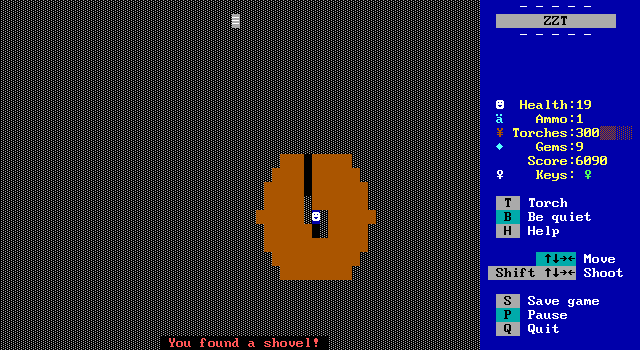
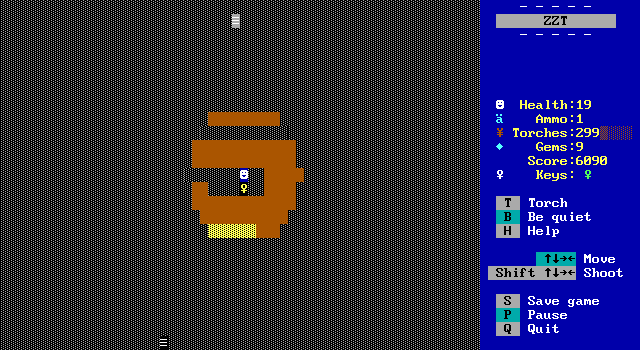
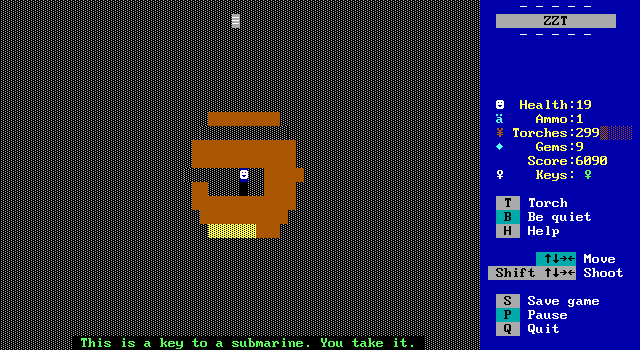
The exploration proves necessary with the rewards being a shovel and key to a submarine!
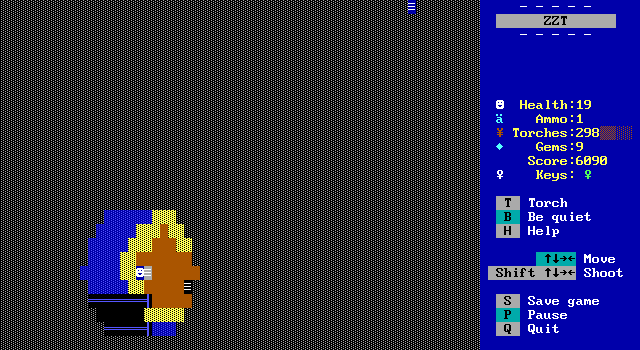
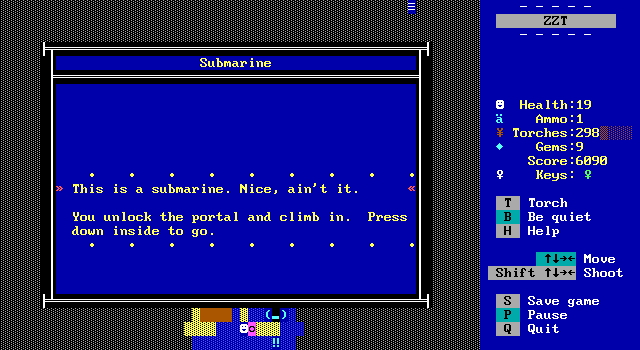
The cave is just that one board, with an exit out the back to the rest of the island which is just a short path to the "submarine".
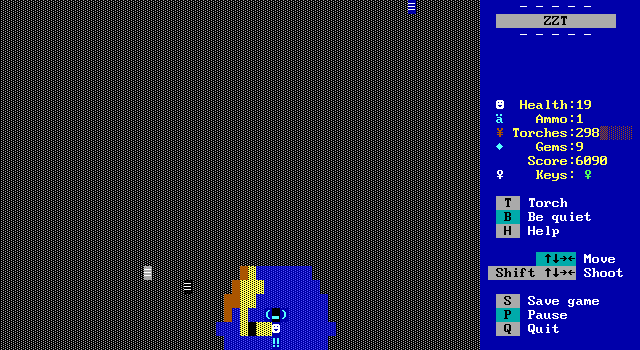
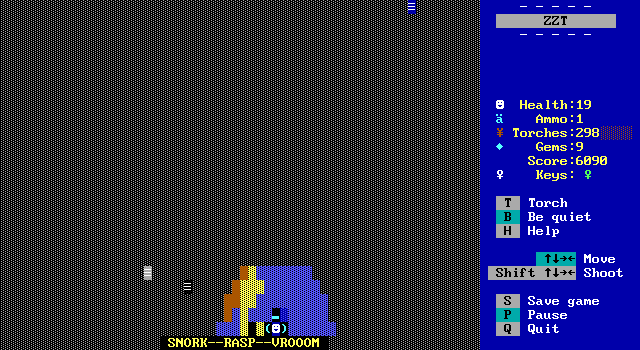
Hell yes. This is gonna be awesome.
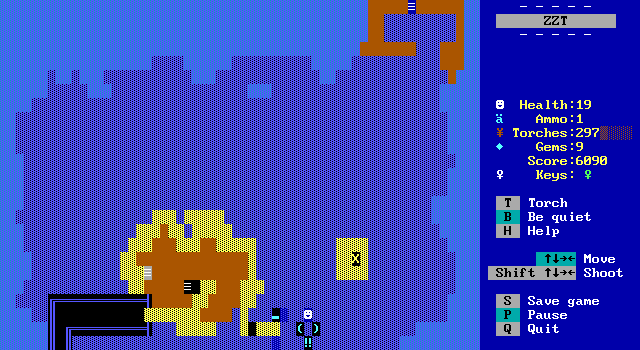
The submarine objects break after a single step.
This submarine is the "power armor" available on one of the miscellaneous boards in Super Tool Kit. You'll find it in several ZZT games, though it just makes the player more bulky and slow.
The submarine immediately breaks because when it turns the water into fake walls to let the player "swim", the arms are on top of water still which isn't affected by the #change command. Once the arms move into place, the water beneath them shows up, and water blocks objects cause the whole submarine to desync and break. Whoops.
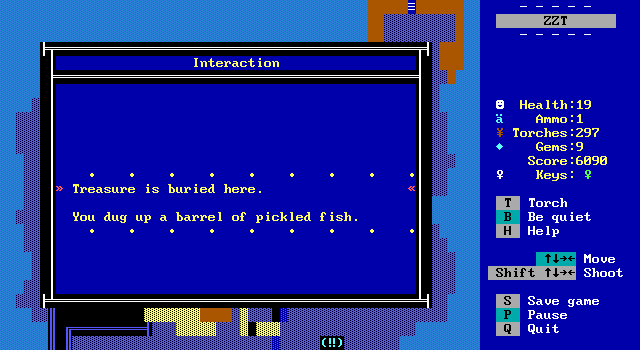
The shovel is necessary to dig up some buried treasure on the other smaller island.
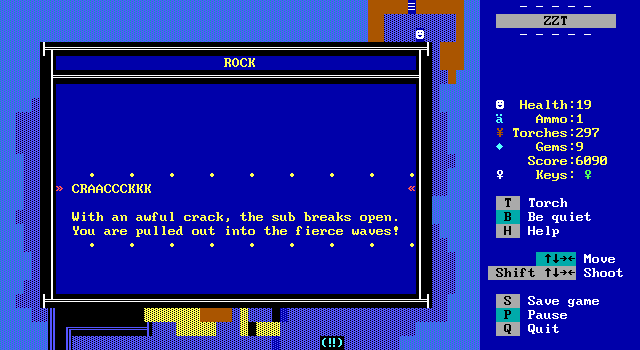
Upon reaching the top of the board, the submarine breaks canonically.
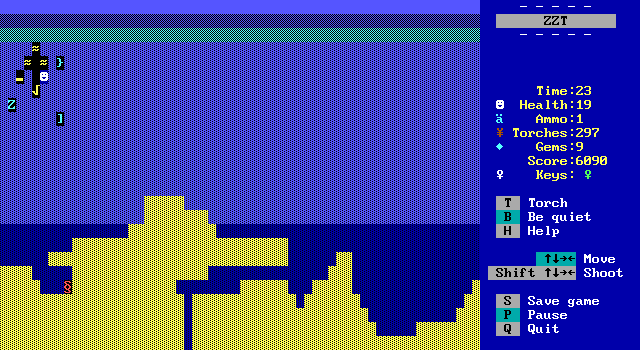
The player proceeds to a board with them underwater with only so much time to finish the board. I do like the portrayal of the wrecked sub.
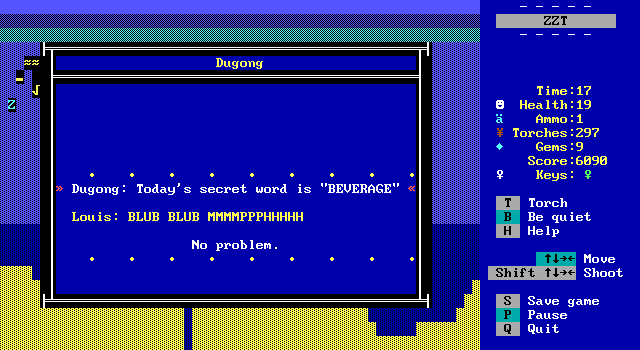
The time limit is pretty tight, but there's a necessary stop at the red dugong to learn the secret word of the day.
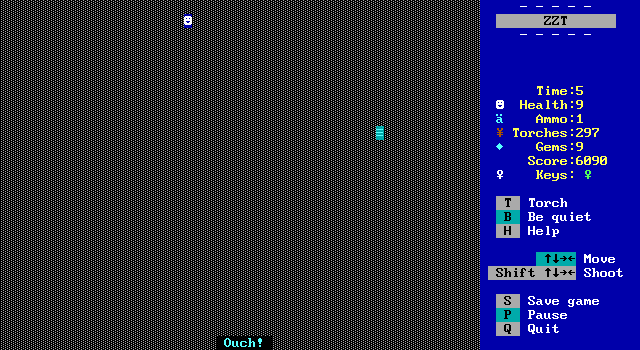
The next screen is dark and has even tighter timing necessary. I may have died taking the time to hit my screenshot key.
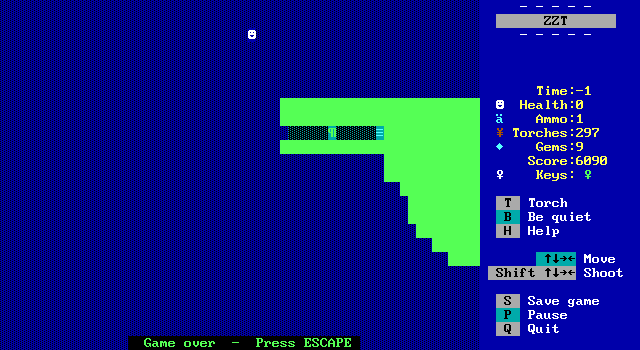
But at least it taught me that ZZT will set the time remaining to a negative number when the player is dead since there's no need to keep the timer running. I believe this is the only way through normal game mechanics to have a counter reach a negative value.
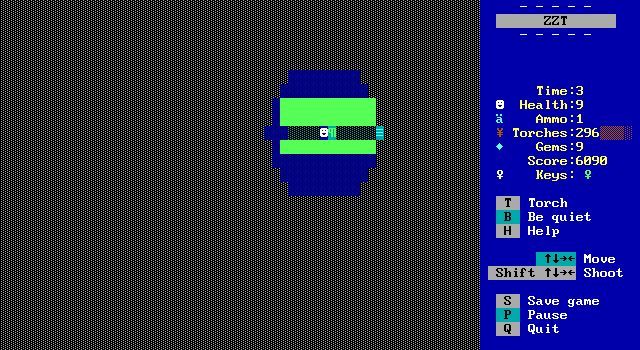
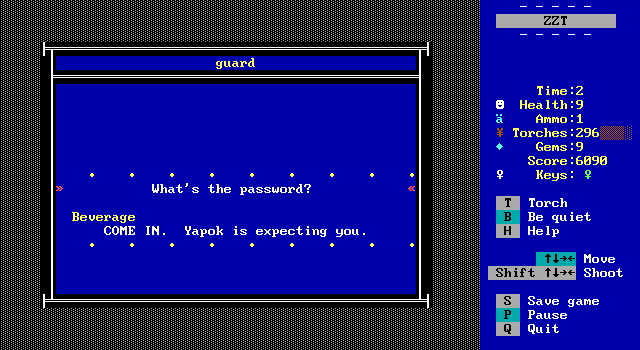
The dugong's password is needed to get out of the ocean and into Yapok's lair. Self-insertion!

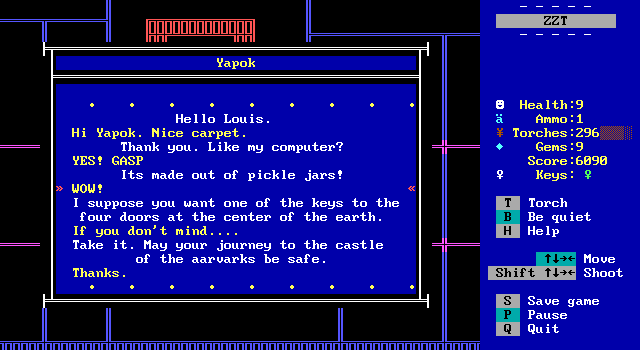
Louis gets to meet his creator who gives him the second key to the castle.
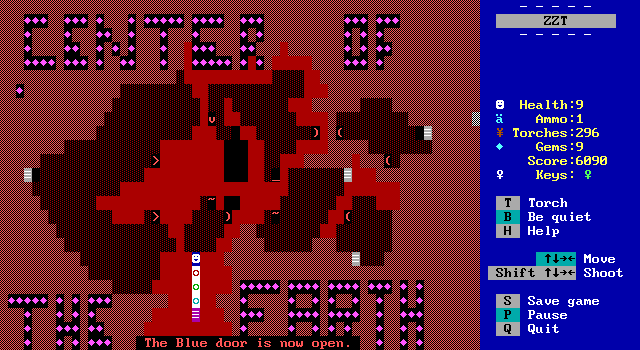
Back in the center of the earth it's two keys down, two to go.
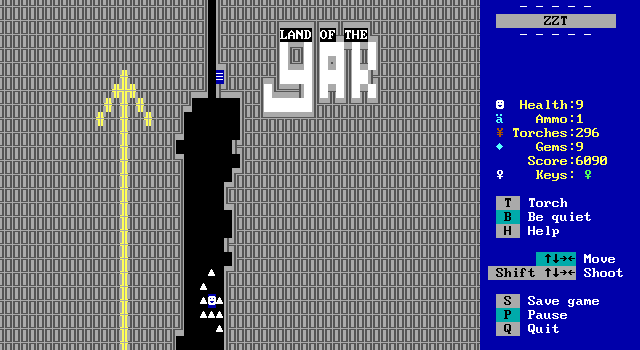

Next up, the Land of the Yak, with more blinking walls that shouldn't be blinking. This opening screen has some danger to it with it being possible to not pay attention and miss the passage making the player unable to proceed.
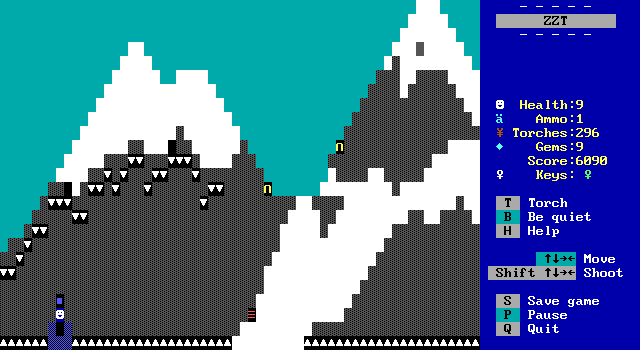
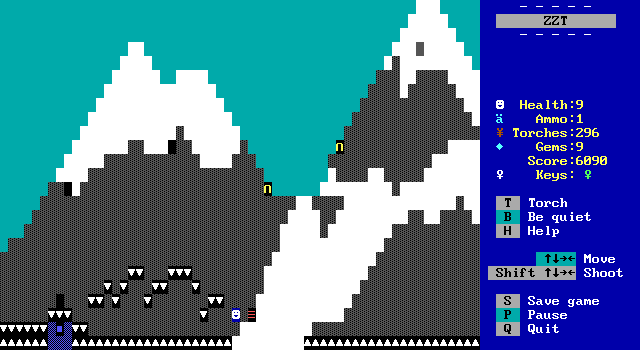
The snowy yak mountains continue the trend with an avalanche of pushers which try to trap the player. A pair of yellow objects make up a chair lift, and the red object operates the controls for them.

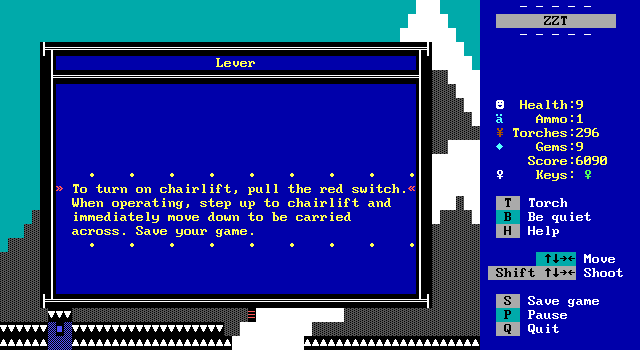
The chairlift is a weird contraption that comes with a warning to save your game before using it.
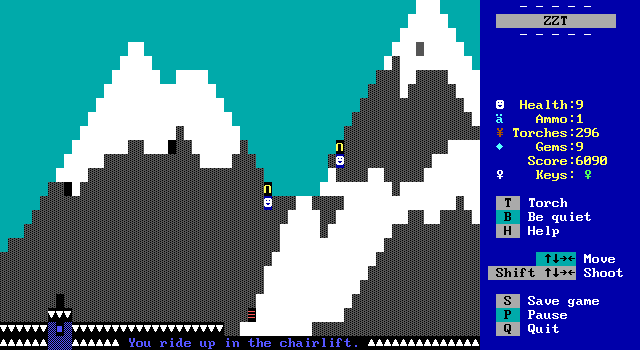
And that's because it's powered by player clones! Their behavior can feel very strange to people who don't know how they work, but the chair lift can be operated multiple times so there's no real danger of breaking things here.
Let's get technical for a moment and explain how this works!
In ZZT's editor, placing a player will always just move the player on the board to the cursor's location, explicitly preventing you from making more than one. Of course, you can still copy the player to the pattern buffer and place clones that way. You can also just straight up #put <dir> player with an object.
So for this chair lift, touching the lower part tells the upper part to put a player to the south, wait a little bit, then shoot south to destroy the clone. Once the clone appears, the player needs to move in a direction that the clone isn't blocked in. ZZT updates elements with stats in the order they were added to the board. The first stat is always the player (unless you go so far as to hex edit a ZZT file), so the actual player presses down and moves down. ZZT keeps processing the stats and eventually reaches the player clone and runs the same player update code on it. It sees that the down key was pressed and moves the REAL player below the clone. The clone stands still.
The reason the actual player moves rather than the clone is because there should only be one player on the screen, and it's the first stat, so rather than search out the stat that needs to have its coordinates changed, ZZT can just be lazy and assume that it wants to update the coordinates of the first stat, setting the actual player's coordinates to the new location!
It's all a wonderful coincidence in ZZT's coding that this works out the way it does. It could've been a situation where the player clone would move itself south instead, or the "move south from here" vector using the first stat's coordinates as the origin point rather than the clone's.
Another coincidence is that the player clone can be destroyed just by shooting it and without losing any health. This happens because when the clone is shot, ZZT only checks if it was the first stat element that got shot when determining if health needs to be reduced.
All of these weird behaviors have done wonders for ZZT's capabilities and if clones had been handled differently, it would have had a tremendous impact on later ZZT games which player clones' unique properties become essential engine features.
And of course all of this here has to happen because there's no way to move the player to an arbitrary location on a board via ZZT-OOP.
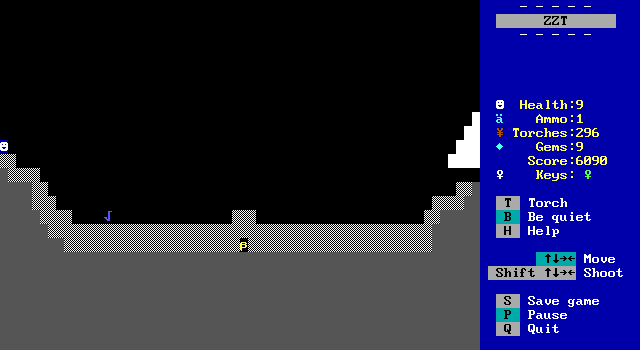
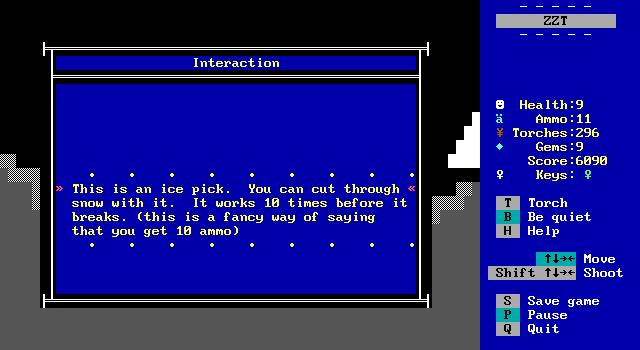
The next room consists of something buried in the ice and a pick with limited uses. Lucky me, I still had my meatloaf ammo so I got an extra shot.
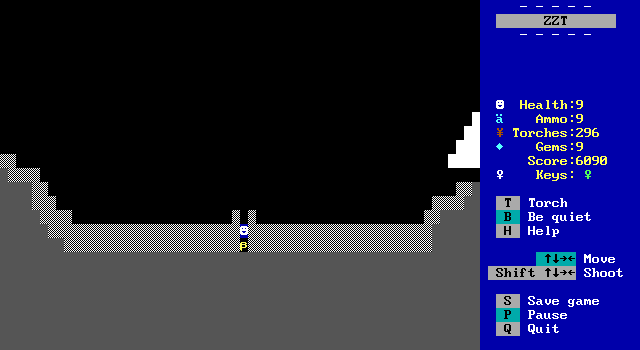
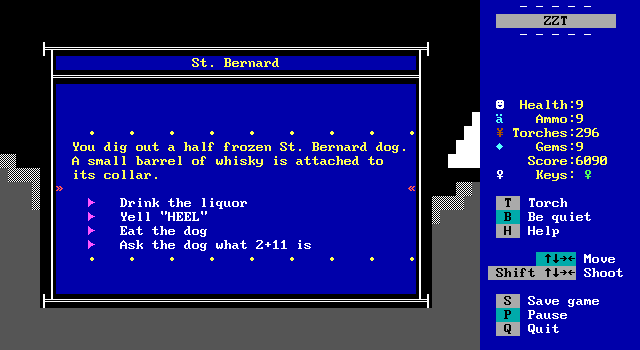
Buried in the ice was a St. Bernard. Louis has several options once again as for what to do.
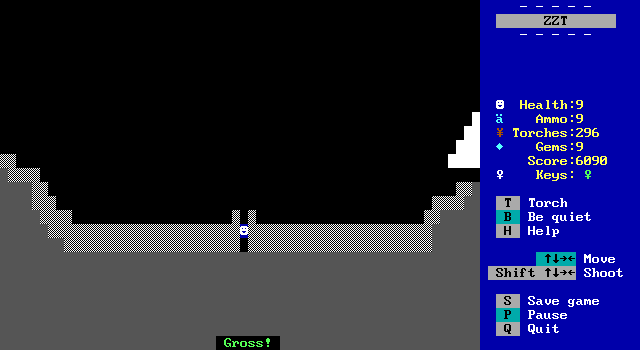
He can eat the dog.
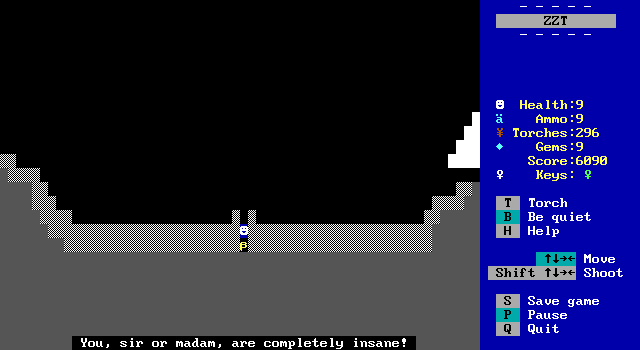
Ask them some math problems.
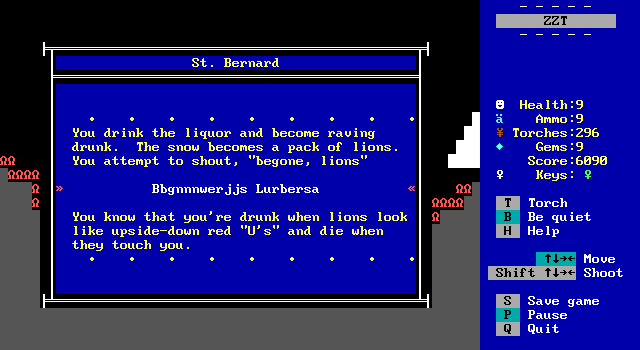
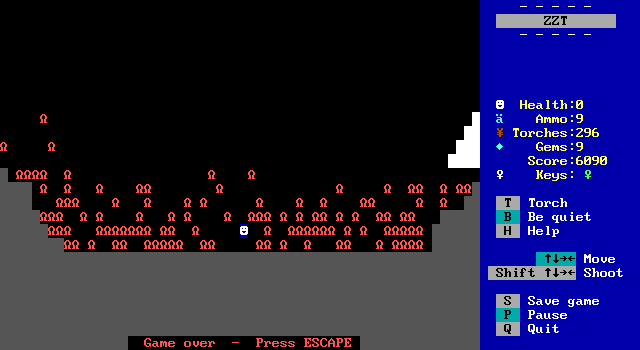
Drink the booze, and get killed for it. (Because you knew one of the choices would result in death.)

Or do a lousy job of training them.
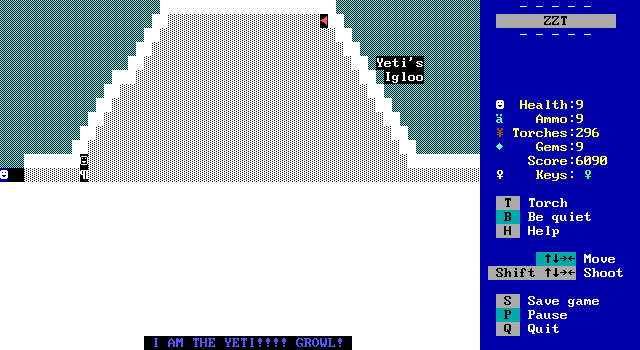
The player will next encounter an angry yeti. A very tall yeti.
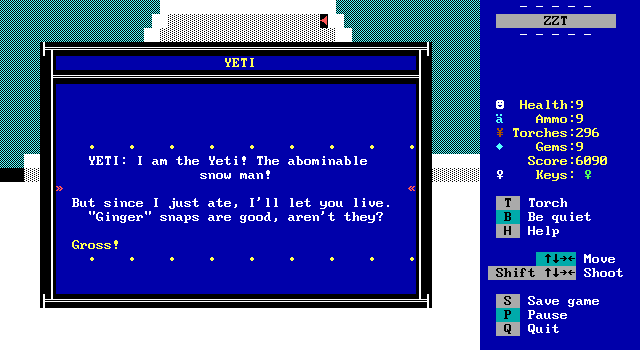
The yeti ate the dog so Louis can pass. If Louis eats the dog, the yeti smells it on him and calls the player a sicko for eating a dog. It's very hypocritical.
If the player does neither, the yeti will ask if it would be plausible for them to eat Louis. Louis can just say no and live, or say yes and get killed.
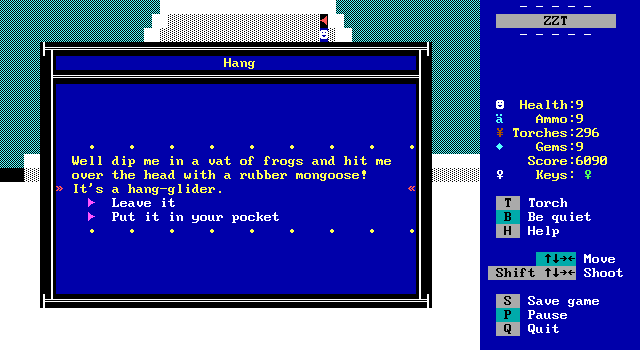
The yeti's igloo also has a hang glider which Louis can snag.

The last board of the mountain is this scenic view of the setting sun.
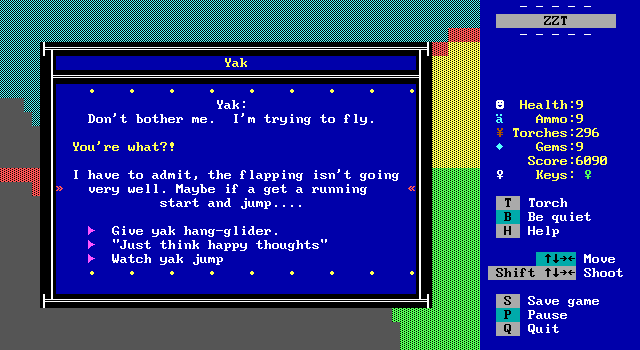
Yak is here and preparing to jump off the cliff to learn to fly.
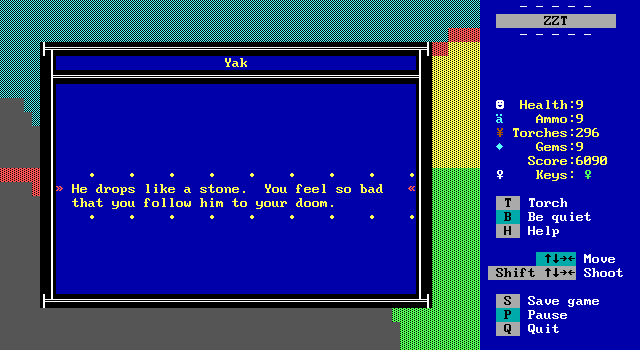
If you just let him do it, he dies, and Louis follows out of guilt.
If you give him the hang glider...
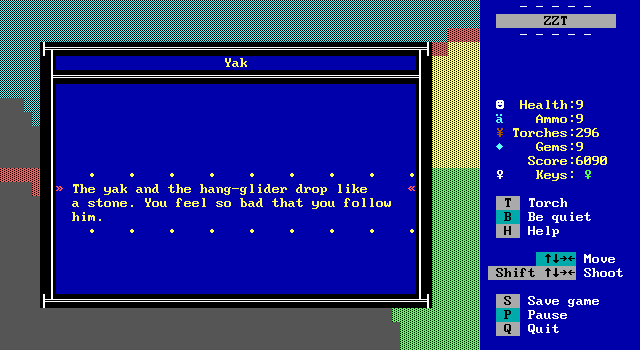
He still plummets! This really caught me off guard and I admit to laughing at the absurdity of it.
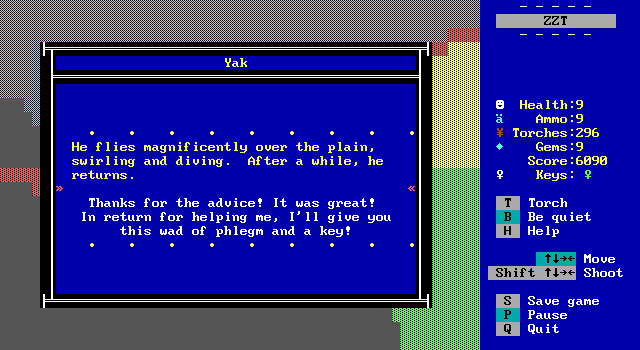
Thinking happy thoughts turns out to be the correct. In addition to the next key, Louis also gets the phlegm needed to plug the leaking oil pipe from earlier.
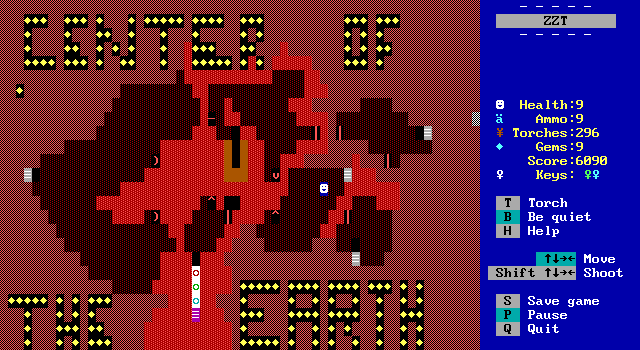
Back in the center of the earth, there's just one path remaining.

